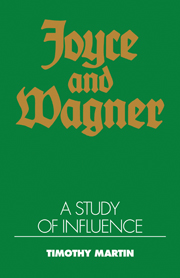5 - The comic rhythm
Published online by Cambridge University Press: 05 November 2011
Summary
Every race has made its own myths and it is in these that early drama often finds an outlet. The author of Parsifal has recognized this and hence his work is solid as a rock.
Joyce, “Drama and Life”In using the myth, in manipulating a continuous parallel between contemporaneity and antiquity, Mr Joyce is pursuing a method which others must pursue after him … It is simply a way of controlling, of ordering, of giving a shape and a significance to the immense panorama of futility and anarchy which is contemporary history.
Eliot, “Ulysses, Order, and Myth”The last three chapters have dealt with Joyce's use of mythic material from nearly all Wagner's mature operas, The Flying Dutchman to Parsifal. But the mythic quality of Joyce's work is more than a question of allusion and thematic parallel. It is also a question of mythic shape. Thomas Mann, in a retrospective article on his Joseph novels, wrote of a change in his interests as his career progressed:
The various stages of life have different inclinations, claims, tendencies of taste … It is probably a rule that in certain years the taste for all purely individual and particular phenomena, for the individual case … fades out gradually. Instead the typical, the eternally human, eternally recurring, timeless – in short, the mythical – steps into the foreground of interest.
- Type
- Chapter
- Information
- Joyce and WagnerA Study of Influence, pp. 112 - 141Publisher: Cambridge University PressPrint publication year: 1991



